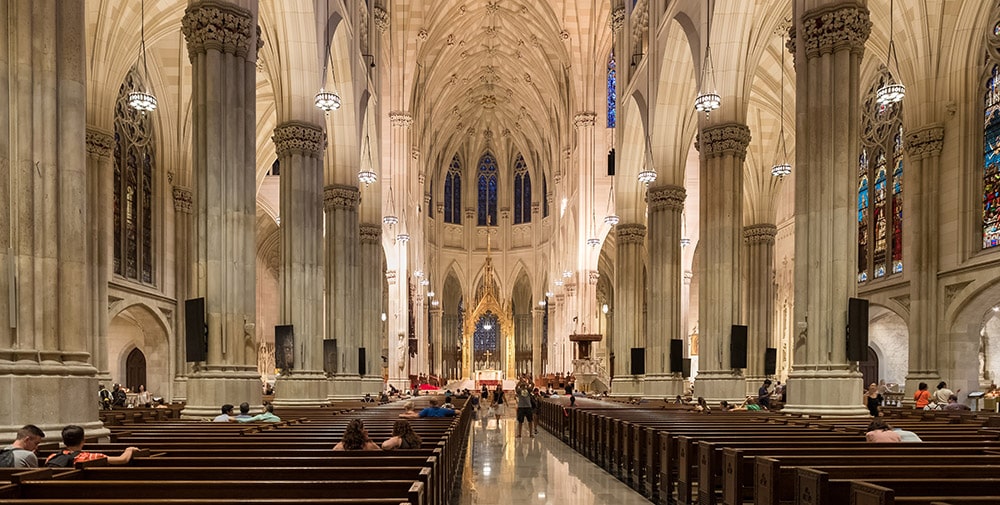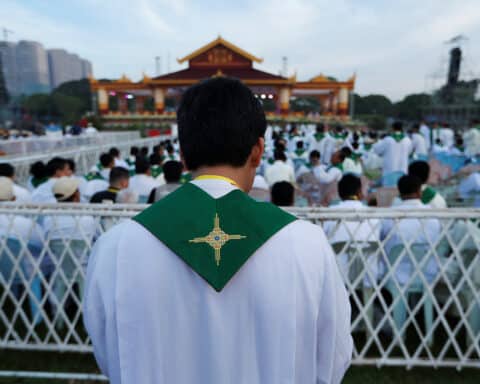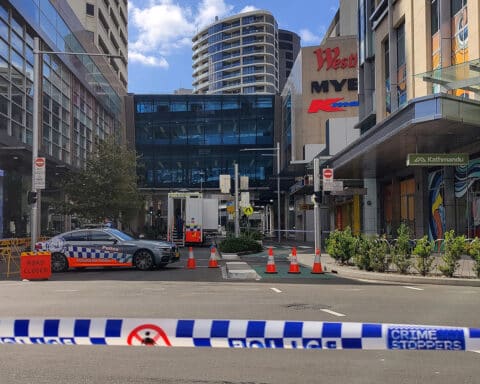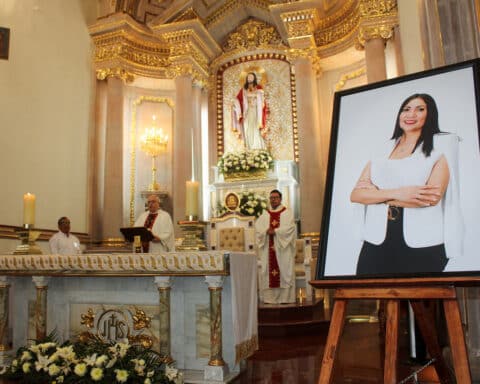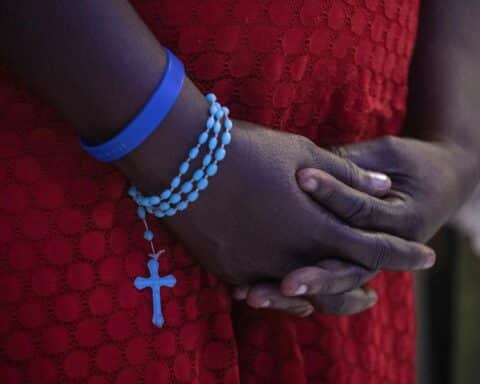The people in the pews next to Chris Pereira probably have no idea he’s armed with a loaded weapon. The handgun he carries at Mass is concealed by a sport coat, a winter jacket or a sweatshirt.
“My wife doesn’t even know when I’m carrying,” said Pereira, 38, a U.S. Air National Guard member and licensed handgun owner who lives in Massachusetts. He asked Our Sunday Visitor not to disclose the parish where he attends Mass.
“In a perfect world, it’d be great if we didn’t have to worry about those things,” Pereia said. “Unfortunately, it’s kind of necessary. I’m going to protect my family, the friends I’m with and other parishioners from anything bad we hope never happens.”
Church leaders are uncomfortable with the idea of individual parishioners arming themselves at Mass, but they share Pereira’s concerns about security and the need to protect the faithful from disturbed or radicalized individuals who would be capable of harming or killing people in a place of worship.
“Our world has changed dramatically over the years. It’s our responsibility to do things to help lessen any potential for incidents, to make our places safer to be to pray and worship,” said Patricia Dailey, who coordinators security for parishes and schools in the Diocese of Orlando, Florida.
Dailey, who is also the associate superintendent of schools for the Diocese of Orlando, told Our Sunday Visitor that the diocese for the last three years has been assessing and improving its security procedures, which include new and simplified emergency response protocols and an emphasis on “situational awareness.”
“This is no longer something that can be an afterthought,” Dailey said. “It needs to be part of our culture. If we’re going to have safe spaces, we all need to care for one another and be an active participant in that process.”
Rise in extremism
With extremism on the rise, synagogues and mosques across the world have been vandalized, firebombed and attacked by gunmen. So have churches. In recent years, many Christians in the United States have been killed and wounded in church shootings. On Feb. 1, three people were shot, two fatally, following a funeral outside a Florida church.
On Dec. 29, a man opened fire during a service at West Freeway Church of Christ in White Settlement, Texas. The gunman killed two members of the church before he was fatally shot by an armed church member. In that attack, which was live-streamed on the internet, at least five other church members drew their own weapons
In 2019, the Texas Legislature passed a law that authorized anyone with a concealed-carry license to bring a weapon into a place of worship. Legislators passed that law after a church shooting in 2017 left 26 people dead in Sutherland Springs. A local resident shot the gunman outside the church.
Lawmakers and others credited that law with saving lives at West Freeway Church of Christ, while others argued that tighter gun control laws would have prevented the attack. Regardless, the incident underscored how vulnerable churches can be to gun violence.
Assessing the problem
“Churches are usually so vulnerable because of the architecture, where people are tightly sitting together in small spaces, facing forward,” said James Nicholson, who served as the U.S. ambassador to the Holy See from 2001 to 2005.
Nicholson, a U.S. Army Vietnam combat veteran who also served as the U.S. Secretary of Veterans Affairs from 2005 to 2007, told Our Sunday Visitor that church architecture, in general, does not have exits that are designed to be convenient or easy for parishioners to quickly evacuate.
“I think that mandates that church leaders begin to think about this issue seriously and take some action to help secure their places of worship,” Nicholson said.
Dioceses across the country are taking steps to assess, improve and implement new security plans for their parishes, schools, office buildings, rectories and other facilities. Some of those procedures include keeping doors locked, securing the perimeter around a building, installing video cameras and training ushers at Mass to look out for and report potential threats to police.
“The first thing is building awareness, and that requires having conversations with the pastoral council in the parish, with those who run parish ministries and those who are on the parish staff,” Archbishop William E. Lori of Baltimore told Our Sunday Visitor.
Among the clergy and Catholic faithful, Archbishop Lori said there needs to be a common commitment to what he called “a culture of safety and security,” which he said hinges on leadership that understands and takes seriously the need to protect against potential threats.
“Given all of the number of mass shootings we’ve witnessed, I think we all have to assume that it could happen, and therefore we all have to be prepared as to what we would do if it did happen,” said Archbishop Lori, who attended a Jan. 13 press conference in Baltimore with other religious leaders who called for extra federal funding for security measures at religious sites in the United States.
Archbishop Lori said the Nonprofit Security Grant Program, which allows houses of worship to apply for up to $100,000 in grants to improve their protection against terror attacks, helped a Catholic school in Baltimore upgrade its security measures.
“If you’re a Catholic school and you’re running close to margin, getting a little boost from those funds really does help you,” Archbishop Lori said.
Having a plan
St. Patrick’s Cathedral in New York City has long been considered a potential target for violence, especially after the Sept. 11, 2001, terrorist attacks, said Msgr. Robert T. Ritchie, the cathedral rector.
“We have an attitude of welcoming people, but there’s also an initial stopping of anyone who is carrying something into the cathedral,” said Msgr. Ritchie, who told Our Sunday Visitor that anyone entering the cathedral first has to go to a secure area where bags are searched and people are “eye-balled” by staff trained to look for suspicious activity.
That basic security procedure averted a potentially dangerous situation last year when a man tried to enter the cathedral while carrying two gas cans, lighter fluid and fire starters. The man, a college graduate student, said he needed to walk through the cathedral to get to his van, which he claimed had run out of gas. Security personnel escorted him out of the building and alerted police officers who arrested the man on charges of attempted arson and reckless endangerment.
“That’s the way the system was meant to work, and it worked perfectly,” said Msgr. Ritchie, who added that the New York Police Department also stations officers outside the cathedral when the threat-level is elevated. Given local gun laws, he said people legally arming themselves is virtually impossible inside St. Patrick’s Cathedral or most locations in New York City.
“And we would definitely not be in favor of that,” Msgr. Ritchie said.
Neither is Archbishop Lori, who said he would be “extremely worried” about people having guns in church. He said a better alternative is for parishes to form security and response teams, noting that virtually every parish has current or retired law enforcement professionals, nurses, doctors, paramedics and other emergency responders.
Pereira, the Massachusetts resident who is a past grand knight of his parish Knights of Columbus council, suggested that pastors could privately ask parishioners who are licensed and trained gun owners to attend certain Masses, or to create more formal security teams.
“It’s not something I stay up all night thinking about or worrying about,” Pereira said. “But it’s definitely thought about, and I choose to be prepared, just in case.”
Brian Fraga is a contributing editor for Our Sunday Visitor.

